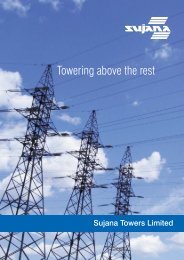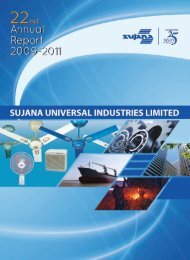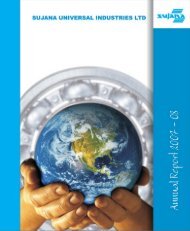You also want an ePaper? Increase the reach of your titles
YUMPU automatically turns print PDFs into web optimized ePapers that Google loves.
SUJANA METAL PRODUCTS LIMITED<br />
Minimum Alternate Tax (MAT) paid in accordance with the tax laws, which gives rise to future economic<br />
benefits in the form of adjustment of future income tax liability, is considered as an asset if there is<br />
convincing evidence that the Company will pay normal tax after the tax holiday period. Accordingly,<br />
it is recognized as an asset in the balance sheet when it is probable that the future economic benefit<br />
associated with it will flow to the Company and the asset can be measured reliably.<br />
The tax effect of the timing differences that result between taxable income and accounting income and<br />
are capable of reversal in one or more subsequent periods are recorded as a deferred tax asset or<br />
deferred tax liability.<br />
Deferred tax assets and liabilities are recognized for future tax consequences attributable to timing<br />
differences. They are measured using the substantively enacted tax rates and tax regulations at the<br />
reporting date.<br />
The carrying amount of deferred tax assets at each balance sheet date is reduced to the extent that it<br />
is no longer reasonably certain that sufficient future taxable income will be available against which the<br />
deferred tax asset can be realized.<br />
Tax on distributed profits payable in accordance with the provisions of Section 115O of the Income<br />
Tax Act, 1961 is in accordance with the Guidance Note on “Accounting for Corporate Dividend Tax”<br />
regarded as a tax on distribution of profits and is not considered in determination of profits for the year.<br />
11. Earnings per Share<br />
The Company reports Basic and Diluted Earnings Per Share (EPS/DEPS) in accordance with<br />
Accounting Standard 20 on “Earnings Per Share”. Basic EPS is computed by dividing the net profit or<br />
loss for the year attributable to equity shareholders by the weighted average number of equity shares<br />
outstanding during the year.<br />
Diluted EPS is computed by dividing the net profit or loss for the year attributable to equity shareholders<br />
by the weighted average number of equity shares outstanding during the year as adjusted for the<br />
effects of all dilutive potential equity shares, except where the results are anti-dilutive.<br />
12. Impairment of assets<br />
The carrying amount of assets, other than inventories is reviewed at each balance sheet date to<br />
determine whether there is any indication of impairment. If any such indication exists, the recoverable<br />
amount of the assets is estimated. The recoverable amount is the greater of the asset’s net selling<br />
price and value in use which is determined based on the estimated future cash flow discounted to their<br />
present values. An impairment loss is recognized whenever the carrying amount of an asset or its<br />
cash generating unit exceeds its recoverable amount. Impairment loss is reversed if there has been a<br />
change in the estimates used to determine the recoverable amount.<br />
13. Provisions, Contingent Liabilities and Contingent Assets<br />
The Company recognises provisions when there is present obligation as a result of past event and it<br />
is probable that there will be an outflow of resources and reliable estimate can be made of the amount<br />
of the obligation. A disclosure for Contingent liabilities is made in the notes on accounts when there<br />
is a possible obligation or present obligations that may, but probably will not, require an outflow of<br />
resources. Contingent assets are neither recognised nor disclosed in the financial statements.<br />
: : 74 : :









